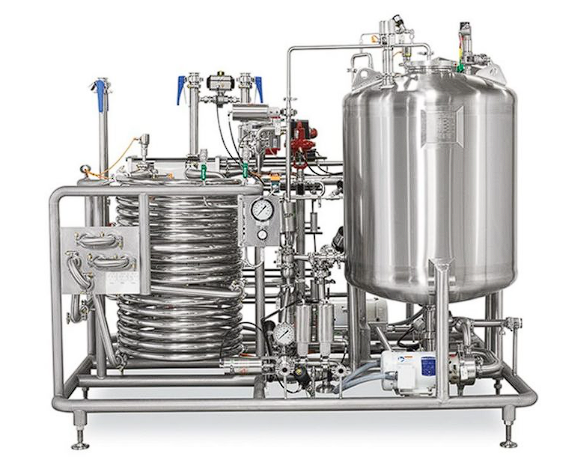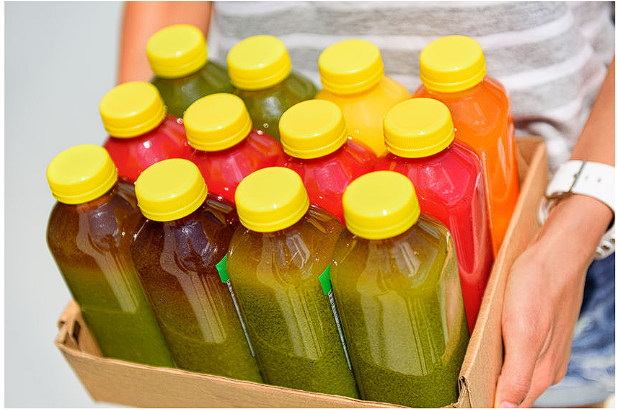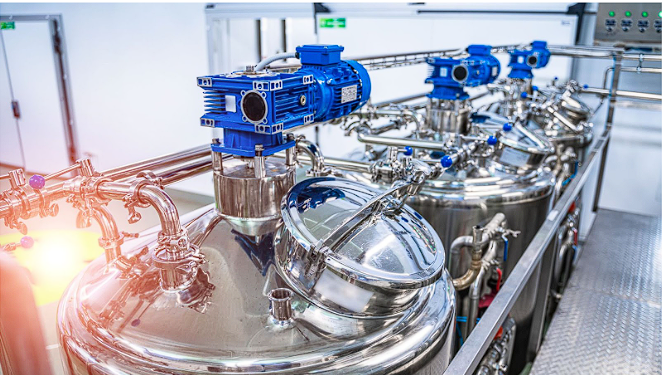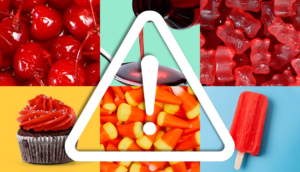- Food Startup Funding: Do you need investors to build a successful food or beverage business? - February 29, 2024
- Explaining Food Certifications & Labeling: Organing, Non-GMO, Halal, Kosher, & More! - February 29, 2024
- Explaining the Meaning of MOQ - February 29, 2024
In the world of food and beverage products, the quest for safer and longer-lasting products has always been paramount. Flash pasteurization, an advanced pasteurization technique, plays a crucial role in achieving these objectives.
How do you know if your food or product needs flash pasteurization? And if it does, how do you find a manufacturer or co-packer that offers this production technology?
This article will review what flash pasteurization is, its benefits and limitations, and how to find the right co-packer for your food or beverage business.
What is Flash Pasteurization?
Flash pasteurization, also known as high-temperature short-time (HTST) pasteurization involves the use of sterile fill technology to eliminate harmful microorganisms from perishable products. Unlike traditional methods that require prolonged exposure to high temperatures, flash pasteurization rapidly heats the product to a specific temperature for 3 to 15 seconds and then quickly cools it down.
This process helps ensure the product is effectively sterilized while minimizing the impact heat can have on its taste, texture, and nutritional value.
What Drinks Use Flash Pasteurization?
When discovered by Louis Pasteur in 1857, pasteurization was used to deactivate unwanted microorganisms in wine. Since then, many industries have adopted flash pasteurization.
The method works in the production of juices, including fruit juices and vegetable juices, as well as dairy-based beverages such as milk. Smoothies, beer, and energy drinks may also need to be flash pasteurized depending on their ingredients.
Food manufacturers that create liquid products that use dairy as a key ingredient will also use flash pasteurization. These products include dressings, sauces, and confectionery products.
How Flash Pasteurization Works
Flash pasteurization begins with the product being rapidly heated between 160°F and 165°F, depending on your beverage. The temperature is carefully chosen to destroy bacteria, yeasts, molds, and other undesirable pathogens that may be present in the product.
To achieve rapid heating, manufacturers use specialized equipment that allows for quick and efficient heat transfer while the liquid moves in a controlled, continuous flow. By minimizing the duration of heat exposure, the process aims to achieve effective sterilization while minimizing any negative impact on the product’s quality. Flash pasteurization is especially beneficial for perishable items that are sensitive to prolonged heat exposure. It allows manufacturers to extend the shelf life of their products while maintaining their freshness and overall quality.
After the product reaches the desired temperature, it’s rapidly cooled down as it continues its controlled flow, exposed to between 39.2° F and 42°F. This rapid cooling is crucial as it helps preserve the sensory attributes of the product, such as taste, texture, and nutritional value while ensuring that it remains safe for consumption.
When Should You Not Use Flash Pasteurization?
While flash pasteurization can be important for the micro bacteria in your beverage products, there are instances where it is not the right process to use. For example, if your beverage is particularly heat-sensitive, flash pasteurization could damage the flavor or natural qualities of the beverage.
Additionally, some beers and ciders rely on the presence of specific enzymes for fermentation or flavor development. Other dairy products may also change in texture when exposed to high temperatures.
Ready to Match With Your Perfect Co-packer?
Other Pasteurization Types

1. Heat Pasteurization
Heat pasteurization is similar to flash pasteurization but the product is not heated and cooled as rapidly. Heat pasteurization heats products for about 30 minutes instead of 3-15 seconds. The products are also heated to a slightly cooler temperature than flash pasteurization. Since this exposes the beverage to a much more significant time frame of high heat, it’s important to ensure this method is right for your beverage product before choosing to implement it.
2. Ultra-high Temperature Pasteurization
Ultra-high temperature pasteurization, also known as UHT pasteurization, involves heating the liquid food product to temperatures as high as 280 degrees Fahrenheit (138 degrees Celsius) for a very short duration, usually around 2 to 5 seconds. The rapid and intense heat treatment effectively kills harmful bacteria, yeasts, and molds, ensuring the product’s safety and reducing the need for refrigeration.
3. Extended Shelf Life Pasteurization
Extended Shelf Life (ESL) pasteurization is unlike traditional pasteurization, which involves heating the product to a high temperature for a short duration. ESL pasteurization uses a combination of milder heat treatment and other preservation techniques.
This method typically involves heating the food product to temperatures between 160 and 190 degrees Fahrenheit (71-88 degrees Celsius) for a longer period up to a few minutes. ESL pasteurization can retain most of the product’s natural flavors, textures, and nutrients, while effectively reducing the presence of spoilage microorganisms.
4. Low-Temperature Long-Time Pasteurization
Low-Temperature Long-Time (LTLT) pasteurization involves heating the food product at lower temperatures, typically between 145 and 165 degrees Fahrenheit (63-74 degrees Celsius), for an extended period ranging from 30 minutes to several hours. LTLT pasteurization is commonly used for delicate products such as dairy, eggs, and certain beverages, where maintaining the product’s sensory attributes is of more importance.
5. Aseptic Processing
Aseptic processing is a food preservation technique that sterilizes both the product and the packaging material separately and then combines them under sterile conditions. This method ensures that the final product is free from harmful microorganisms.
In aseptic processing, the product is pasteurized according to its sterilization needs. Then, the packaging material, such as containers or cartons, is also sterilized through various means, including steam or hydrogen peroxide. The sterile product and packaging are then brought together in a sterile environment, usually using aseptic filling systems, which help prevent any contamination from occurring.
Flash Pasteurization Benefits

Quick & Efficient
Flash pasteurization is quicker and more efficient compared to traditional pasteurization methods. Its efficiency lies in the ability to achieve the desired pasteurization temperature within seconds, significantly reducing processing time and energy consumption.
This enhances productivity and cost-effectiveness for manufacturers while ensuring a higher level of food safety and quality for consumers.
Kills Bacteria & Microorganisms
By subjecting the product to high temperatures for a brief period, flash pasteurization efficiently targets and destroys bacteria, yeast, molds, and other harmful microorganisms, ensuring the safety and quality of the final product.
This method is particularly advantageous for delicate items, such as juices, dairy products, and liquid foods, as it eliminates pathogens without compromising the taste, texture, or nutritional value of the product.
Preserves Flavor & Quality
Unlike conventional pasteurization methods that can lead to flavor degradation and texture changes, flash pasteurization’s quick heating and cooling process minimizes these undesirable effects. This technique effectively kills bacteria and microorganisms while preserving the natural flavors, aromas, and overall sensory characteristics.
This not only enhances consumer satisfaction but also ensures that the product retains its quality and freshness over an extended shelf life.
Maintains Nutritional Value
Flash pasteurization also preserves essential vitamins, minerals, enzymes, and other nutrients. This ensures that the final product retains its nutritional integrity, providing consumers with healthier and more wholesome options.
Flash Pasteurization Challenges

Less Effective Than Other Pasteurization Technologies
While flash pasteurization efficiently eliminates harmful microorganisms, some other methods, such as high-pressure processing (HPP) or ultra-high temperature (UHT) pasteurization, may offer a higher level of microbial inactivation.
Though these alternative technologies can achieve more thorough sterilization, they may negatively impact the quality of the product.
Less Control & Monitoring
Due to the rapid heating and cooling nature of flash pasteurization, there may be limited opportunities for real-time monitoring and adjustments. This can pose challenges in ensuring consistent and uniform pasteurization across all batches, particularly for larger-scale operations.
Additionally, the short duration of the process may make it difficult to accurately assess the extent of microbial inactivation or to detect any potential deviations or variations in the pasteurization effectiveness.
This lack of control and monitoring could lead to a higher risk of inadequate pasteurization or uneven treatment, potentially compromising the safety and quality of the final product. It is crucial for manufacturers utilizing flash pasteurization to implement comprehensive quality control measures and rigorous testing protocols to mitigate these limitations and maintain product safety.
Can Require More Energy
The rapidness of the heating and cooling processes can require the generation of significant heat energy. This increased energy demand can be a concern from both economic and environmental perspectives. The energy-intensive nature of flash pasteurization may lead to higher operational costs for manufacturers, particularly for large-scale production.
Some Flavor Loss
Due to potential flavor loss, flash pasteurization may not be the best technique for some products. Its process may cause subtle changes in flavor profiles, leading to a slight loss or alteration in taste. While efforts are made to minimize these effects, especially by using precise temperature control, some delicate flavors and aromas may still be affected.
However, the extent of flavor loss varies depending on the specific product and processing conditions. Manufacturers can mitigate this disadvantage by conducting thorough sensory evaluations and implementing quality control measures to maintain the desired flavor characteristics throughout the flash pasteurization process.
Find a Contract Manufacturer with the Right Pasteurization Capabilities for Your Product
Discovering a contract manufacturer with the perfect pasteurization capabilities for your product is a game-changer that will propel your business to new heights. You’ll just need to find a manufacturer equipped with state-of-the-art pasteurization techniques so you know your product will meet the highest standards of safety, quality, and taste.
While you can spend months (or years) researching and cold calling manufacturers on your own…PartnerSlate can find you the perfect coman or copacker for you in just days. Through the PartnerSlate platform, food businesses make a profile, list their project, and then quickly connect with contract manufacturers from the largest network of comans you can find.
Simply start by creating a profile and listing your project and we’ll connect you with a selection of manufacturers that could all be the perfect fit–whether or not that includes flash pasteurization processes!



